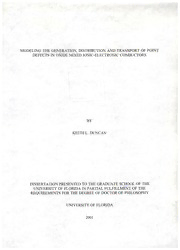
Modeling the generation, distribution and transport of point defects in oxide mixed ionic-electronic conductors PDF
Preview Modeling the generation, distribution and transport of point defects in oxide mixed ionic-electronic conductors
MODELINGTHEGENERATION,DISTRIBUTIONANDTRANSPORTOFPOINT DEFECTSINOXIDEMIXEDIONIC-ELECTRONICCONDUCTORS BY KEITHL.DUNCAN DISSERTATIONPRESENTEDTOTHEGRADUATESCHOOLOFTHE UNIVERSITYOFFLORIDAINPARTIALFULFILLMENTOFTHE REQUIREMENTSFORTHEDEGREEOFDOCTOROFPHILOSOPHY UNIVERSITYOFFLORIDA 2001 ACKNOWLEDGMENTS I would like to thank my advisor. Dr. Eric D. Wachsman, for his support, encouragementandfacilitationofmygraduateresearch. Underhistutelage,Ihavecomea longwayintheburgeoningfieldofsolidstateelectrochemistryandhavebeenequippedto goevenfarther. Iamalsogratefultomycommitteemembers.Dr.R.T.Dehoff,Dr.R. Hummel,Dr.M.Orazem,Dr.W.SigmundandDr.S.Sinnott,formakingthemselves accessiblefordiscussionandforchallengingmetoexpandthehorizonsofmyresearch. Iwouldliketothankmyfamily. MywifeNicoleandsonMatthewhavegivenme tremendoussupportthroughtheordealsofdoctoralresearch. Theyallowedmetotake themfromtheircontentedlifeinJamaicaandtheyenduredmuchhardshiptohelprealize myambitions. Moreover,theyenabledmetoretainabalancedperspective,helpingmeto smellafewrosesalongthejourney. Imustalsoexpressmysincereappreciationforthe effortsofmymother,MerdeanBennett,asingleparentwhogaveallshecould,often undertryingconditions. Finally,IthankGodwhothroughhisHolySpiritandthesavinggraceofJesus,His son,shepherdedmethroughtheyears. Godhasblessedmeincountlessway. Heblessed mewiththisopportunitytostudy. Hemadeawaywheretherewasnone. Heprovided mewiththebestsituationinwhichtothrive. MayallofmylifebetoHishonorand glory. AdmajoremDeigloriem. 11 TABLEOFCONTENTS E2ge ACKNOWLEDGMENTS ii LISTOFTABLES vi LISTOFFIGURES vii KEYTOSYMBOLSANDABBREVIATIONS xi ABSTRACT xvi CHAPTERS INTRODUCTION 1 1 1.1 MixedIonic-ElectronicConductors 1 1.2 ApplicationsofOxideMixed-IonicElectronicConductors 2 1.3 ResearchChallengesandOpportunities 4 1.4 MajorAssumptionsUsedinModelDevelopment 7 1.5 Summary 11 2THERMODYNAMICSOFOXIDEMIXEDIONIC-ELECTRONIC CONDUCTORS 12 2.1 Introduction 12 2.2 PreviousModels 14 2.2.1 BrouwerApproach 14 2.2.2 OxygenPartialPressureasaFunctionofDefectConcentration 15 2.2.3 NumericalMethods 16 2.3 DefectGeneration 17 2.3.1 DefectEquationsandChargeNeutrality 17 2.3.2 RelationshipsamongEquilibriumConstants 24 2.3.3 RelationshipsbetweenSmallPolaronConcentrations 27 2.3.4 ModelingtheFunctionalDependenceofDefectConcentrationonPq2 30 2.3.5 GeneralizedEquationsforDefectConcentrationDependenceonPq2 38 2.3.6 ResultsandDiscussion 40 2.4 CaseStudy:Acceptor-DopedCeria 47 22..44..12 FEuvnacltuiaotnianlgDtheepeMnadgennitcuedoefoDfeftheectEqCuoinlciebnrtiruamtiCoonnsotnanPtq,2Kr 4583 2.4.3 TransportProperties:Conductivity,TransferenceNumberandFlux 64 iii 2.4.4 DefectAssociation 69 2.5 Summary 76 3 SPATIALDISTRIBUTIONANDTRANSPORTOFDEFECTS INOXIDEMIXEDIONIC-ELECTRONICCONDUCTORS 77 3.1 Introduction 77 3.2 ReviewofPreviousModels 79 3.3 GeneralEquations 83 3.3.1 TransportPropertiesandLaws 83 3.3.2 Current-VoltageRelationshipsinanSOFCorElectrocatalyticReactor 88 3.3.3 Open-circuitConditionsandEffectiveTransferenceNumber 91 3.4 ModelingDefectDistributionandTransportinMIECsbyAssuminga LinearElectricField(V2<f>=0):TheLinearPotentialModel 94 3.4.1 GeneralDevelopmentoftheLinearPotentialModel 95 3.4.2 AmbipolarDiffusioninOpen-CircuitConditions 98 3.4.3 EstimatingtheMagnitudeoftheEquilibriumConstantsKrandKm 101 3.5 BoundaryConditions:DefectConcentrationsattheBoundaries 103 3.5.1 ExpressionsfortheDefectConcentrationsattheBoundaries 103 3.5.2 EffectofPotentialDifferenceontheEquilibriumConstants 104 3.6 ResultsandDiscussionfortheLinearPotentialModel 109 3.6.1 SpatialDistributionofDefects:DefectConcentrationProfiles Ill 3.6.2 AverageDefectConductivityandEffectiveIonicTransferenceNumber....120 3.6.3 DefectFluxDensityandCurrentDensity 125 3.6.4 Efficiency 132 3.7 ModelingDefectDistributionandTransportinMIECswithoutAssuming aLinearElectricField:TheNon-LinearPotentialModel 134 3.7.1 GeneralDevelopmentoftheModel 134 3.7.2 LimitingCases 138 3.7.3 AverageConductivityandEffectiveTransferenceNumber 140 3.8 ResultsandDiscussionfortheNon-LinearPotentialModel 142 3.8.1 Flux,Current,Conductivity,TransferenceNumberandEfficiency 142 3.8.2 SpatialDistributionofDefectsandPotential 146 3.9 ExperimentalVerificationoftheModel(inOpen-CircuitConditions) 149 3.10Summary 163 4BILAYEREDMEMBRANES 166 4.1 Introduction 166 4.2 BilayerModel 170 4.2.1 Open-CircuitConditions 170 4.2.1.1 “Thermodynamic”approach 171 4.2.1.2 “Transport”approach 174 4.2.2 Closed-CircuitConditions 180 4.3 Summary 187 IV 5 CONCLUSIONS 190 APPENDICES A EVALUATINGTHE“EQUILIBRIUMCONSTANTS”(K-ANDK+)FORTHE SMALLPOLARONFORMATIONREACTION 194 B DEFECTGENERATIONFORMULAEFOROXYGENINTERSTITIALSAND CATIONVACANCIES 198 C MODELINGTHEACCOMMODATIONOFCUBICBISMUTHOXIDEIN THEFLUORITESTRUCTURE 200 REFERENCES 202 BIOGRAPHICALSKETCH 207 v LISTOFTABLES Table page 2-1 TypicaldopantconcentrationsandunitcellvolumesincommonoxideMIECs 22 2-2 Summaryofdefectequationsforfluoritesandperovskites 25 2-3 Proportionalityrelationshipsbetween(dominant)defectconcentrationsandPo2 foreachBrouwerregime 43 22--4 ComparisonbetweenthedominantdefectspairsoftheBrouwerapproachand 3- thedominantdefecttriadsofthepresentmodel 44 2-5 ValuesoftheconstantsusedinthenumericalsolutionofSDC’sdefectequations..49 2-6 Calculatedvaluesof0andKrforSDCfromtheuncorrected<f>ocdataof Godickemeieretal.[44,45] 57 2-7 Calculatedvaluesof0andKrforSDCfromthecorrectedOocdataof Godickemeieretal.[44,45] 58 8 CalculatedvaluesofKrfromthermogravimetrydataofKobayashietal.[47] 60 1 Calculatedvaluesof0andKrforSDCfromthecorrectedd>ocdataof Godickemeieretal.[44,45] 102 3-2 CalculatedvaluesofKr,Km,lion,andd>app 110 3-3 ValuesofKrandDe/Dyusedtofitthemodeltoexperimentaldata 157 vi LISTOFFIGURES 1- 2F-igure page 1-1 SOFCPowergeneration 2 2 Overarchingtheoreticalframeworkofthisstudy 8 1 Unitcellof(a)thefluoritestructureand(b)theperovskitestructure 13 2-2 ReactionsbetweentheoxygensublatticeofanoxideMIEC(fluoritestructure) andanexternalgasphase 18 2-3 DefectconcentrationdependenceonPq2forafluorite-structuredMIEC 41 2-4 DefectconcentrationdependenceonPq>2foraperovskite-structuredMIEC 42 2-5 SmallpolaronconcentrationdependenceonPo2forafluorite-structured MIEC 45 2-6 SmallpolaronconcentrationdependenceonPo2foraperovskite-structured MIEC 45 2-7 Variationofnon-stoichiometrywithPq2forafluorite-structuredMIEC 46 2-8 Variationofnon-stoichiometrywithPo2foraperovskite-structuredMIEC 47 2-9 DefectequilibriumdiagramofSDCobtainedthroughnumericalsolutionofits defectequations 50 2-10 DefectequilibriumdiagramofSDCintheregionofinterest(reducedfrom Figure2-9) 51 2-11 ComparisonofSDC’sDEDobtainednumerically(solidsymbols),fromthe model(lines),andfromPoratandTuller[11](opensymbols) 53 2-12 Modeleda(P)fittedtoexperimentaldatafromEguchietal.[49]forSDC 66 Vll d 5 2-13 AnoxideMIECinanarbitraryPq2gradient 67 2-14 Oxygenfh\x,jo2{P),througha1mmthickMIEC 69 22--15 Dependenceofcy0(o)andcsp-(0)onPq2with(symbols)andwithout(lines) theeffectofdefectassociation 73 3- 2-16 Oxygenpartialpressuredependenceofcy0,csp-,cji,Cd2andc3 74 17 EffectofKrontheformationofdefectassociates 75 1 EquivalentcircuitdiagramofanSOFCinclosed-circuitconditions 89 3-2 AmbipolardefectfluxinanSOFCinopen-circuitconditions 99 3-3 EffectofAOonthereactionprofileoftheexternalequilibriumreaction betweenanMIECandagasphase 105 3-4 Oxygenvacancyconcentrationprofilesinanrz-typeMIECwithfixedBDCs...112 3-5 Electronconcentrationprofilesinan«-typeMIECwithfixedBDCs 113 3-6 Oxygenvacancyconcentrationprofilesinap-typeMIECwithfixedBDCs 114 3-7 Holeconcentrationprofilesinap-typeMIECwithfixedBDCs 11 3-8 Oxygenvacancyconcentrationprofilesinanrc-typeMIECwithpotential dependentBDCs 116 3-9 Electronconcentrationprofilesinan«-typeMIECwithpotentialdependent BDCs 116 3-10 Oxygenvacancyconcentrationprofilesinap-typeMIECwithpotential dependentBDCs 117 3-11 Holeconcentrationprofilesinap-typeMIECwithpotentialdependent BDCs 117 3-12 Comparisonofthespatialdistributionofoxygenvacanciesandelectronsinan n-typeMIEC(SDC)withpotentialdependentBDCs 119 3-13 Comparisonofthespatialdistributionofoxygenvacanciesandholesina p-typeMIEC(ESB)withpotentialdependentBDCs 120 3-14 Averageconductivityandeffectivetransferencenumberofann-typeMIEC....121 viii 3-15 Averageconductivityandeffectivetransferencenumberofap-typeMIEC 122 3-16 Defectfluxdensityinan«-typeMIEC(SDC) 126 3-17 Defectfluxdensityina/?-typeMIEC(ESB) 127 3-18 Defectcurrentdensityinan«-typeMIEC(SDC) 130 3-19 Defectcurrentdensityinap-typeMIEC(ESB) 131 3-20 Currentandpowerefficiencyofann-typeMIEC(SDC) 133 3-21 Currentandpowerefficiencyofap-typeMIEC(ESB) 133 — 3-22 Defectfluxdensityinanrc-typeMIEC Non-LinearPotentialModel 143 — 3-23 Defectcurrentdensityinann-typeMIEC Non-LinearPotentialModel 143 3-24 Averagedefect—conductivityandeffectivetransferencenumberinann-type MIEC(SDC) Non-LinearPotentialModel 145 — 3-25 Oxygenvacancyconcentrationprofileinan«-typeMIEC Non-Linear PotentialModel 146 — 3-26 Electronconcentrationprofileinan«-typeMIEC Non-LinearPotential Model 147 3-27 Compari—sonofthespatialdistributionofvacanciesandelectronsinan«-type MIEC Non-LinearPotentialModel 148 3-28 Spatialdistributionofpotentialinan«-typeMIEC 149 3-29 Setupofthefuelcellapparatus 150 3-30 Open-circuitvoltageversusOsensorat800°C 151 3-31 Open-circuitvoltageversusOsensorat750°C 152 3-32 Open-circuitvoltageversus<bSensorat700°C 153 3-33 Open-circuitvoltageversusOsensorat650°C 154 3-34 Open-circuitvoltageversusQ>Sensorat600°C 155 3-35 Open-circuitvoltageversus sensorat550°C 156 ix 3-36 Open-circuitvoltageversus0?sensorat500°C 157 33--37 PlotsofKrandDe/Dyversusreciprocaltemperature 158 4- 3-38 ComparisonoftheSDC-gasandSDC-Pt-gasinterfaces 159 39 Open-circuitvoltage,<f>ocversusOsensor(<&th)at800°Cwithout“fitting” 164 1 Conceptualrepresentationofabilayeredsolidoxidemembrane 167 4-2 ThicknessratiodependenceoninterfacialPo1inopen-circuitconditionsat 800°C 176 4-3 ThicknessratiodependenceoninterfacialPo2inopen-circuitconditionsat 500°C 178 4-4 ThicknessratioversuspotentialdifferenceacrosstheESBlayerinclosed-circuit conditionsat800°C 184 4-5 ThicknessratioversuspotentialdifferenceacrosstheESBlayerinclosed-circuit conditionsat500°C 185 4-6 OxygenvacancyconcentrationversuspotentialacrosstheESBlayer 187 x
